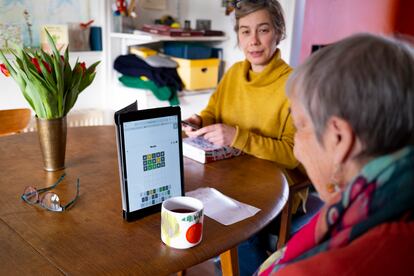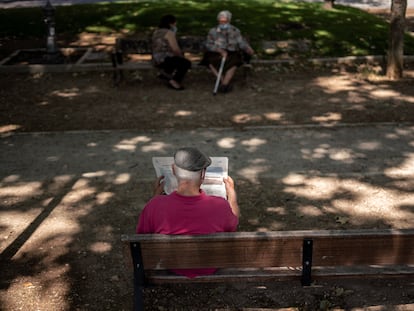Technology with seniors in mind: Simplified cellphones and watches that monitor vitals
New products are seeking to address the needs of the elderly, from devices that monitor blood oxygen levels to services that send alerts in cases of emergency

Population aging is a trend that is being seen in many parts of the world. In Europe, for example, the percentage of the over-80 population doubled between 2001 and 2020. So, it’s not surprising that many tech companies are focusing on developing devices and services that support the elderly in their everyday life, provide assistance in emergencies, and keep track of health indicators.
Cellphones adapted to the elderly feature large keys, enlarged texts and simplified functions. In this way, the elderly can stay connected online and enjoy popular apps such as WhatsApp. The company SPC, for example, has developed ZEUS 4G PRO, an Android cellphone model with large colorful icons, physical keys to pick up and hang up, and services such as an SOS button, which warns selected contacts of an emergency. It also includes other features for family members, such as being able to remotely configure some of the phone’s features and to receive notifications if it is unusually inactive.
While cellphones are having to adapt to the needs of the elderly, wearable technology already has functions that are useful for seniors, such as counting steps, monitoring sleep and keeping track of health variables such as heart rate, blood oxygen and breathing rate. This information can help the elderly stay active and take control over their wellbeing.
Although these devices are not specifically designed for older adults, there are very simple models on the market, as well as devices that focus on these useful functions. For example, the affordable Xiaomi Smart Band 7 has more than two weeks of battery life, and monitors different health variables; and the Apple Watch SE — which is Apple’s basic model — can be linked to a family member’s iPhone, so they are notified of emergencies in the event of a fall. The device also record electrocardiograms.
GPS and vital signs
If an elderly person is easily disoriented, they may wander off or spend long bouts of time alone. A GPS locator is one way to bring peace of mind to their families. When linked to a cellphone app, these devices can tell family members exactly where they are at all times. They also establish safe areas (sounding warnings if the elderly person leaves the marked perimeter), detect falls, and include buttons that can immediately send warnings to emergency services and relatives.
Some of these devices are very discreet and look like watches, such as Nock Senior, which can also make phone calls. Others are in the shape of a keychain, such as the Leotec Tracker GPS, which allows the user to see the exact route the device has taken and its location with a margin of error of five meters. Most devices require a data connection to work and, in many cases, a monthly subscription must also be paid.
On the less digital side of technology, resistance bands, weights and dumbbells can help older adults stay active and in good physical condition. Exercise is key to reducing pain, building strength and agility, improving balance and maintaining a good heart and respiratory rate. Another useful product is foot and hand pedals. These come in active mode, where the user pedals using their own strength, and in passive form, where the movement is performed automatically, for example with this motorized pedal from Exerpeutic. In both cases, the product helps to improve blood circulation, strengthen muscles and keep the body active.
Today, it is easy to find devices to monitor all kinds of variables related to health. The most popular monitor blood pressure, such as the OMROM X7 Smart, which can detect the possibility of atrial fibrillation; and blood glucose, such as the Sinocare kit, which has auto calibration technology. In addition to these products, there are other less well-known devices, such as pulse oximeters (which measure the saturation of oxygen in red blood cells) and ECG sensors. There are also smart pillboxes such Ellie, which sends reminders to take pills and runs reports to see if all doses have been taken.
Sign up for our weekly newsletter to get more English-language news coverage from EL PAÍS USA Edition
Tu suscripción se está usando en otro dispositivo
¿Quieres añadir otro usuario a tu suscripción?
Si continúas leyendo en este dispositivo, no se podrá leer en el otro.
FlechaTu suscripción se está usando en otro dispositivo y solo puedes acceder a EL PAÍS desde un dispositivo a la vez.
Si quieres compartir tu cuenta, cambia tu suscripción a la modalidad Premium, así podrás añadir otro usuario. Cada uno accederá con su propia cuenta de email, lo que os permitirá personalizar vuestra experiencia en EL PAÍS.
¿Tienes una suscripción de empresa? Accede aquí para contratar más cuentas.
En el caso de no saber quién está usando tu cuenta, te recomendamos cambiar tu contraseña aquí.
Si decides continuar compartiendo tu cuenta, este mensaje se mostrará en tu dispositivo y en el de la otra persona que está usando tu cuenta de forma indefinida, afectando a tu experiencia de lectura. Puedes consultar aquí los términos y condiciones de la suscripción digital.
More information
Archived In
Últimas noticias
Welcome to the post-religion era: The idea of Christianity as the absolute truth has become obsolete
‘I thought you would like it’: The risky sexual practice popularized by TV shows and TikTok
The digitalization of tourism: ‘They promise experiences and gave us the worst possible one’
Mexican peso defies uncertainty with forecasts of a new period of stability in 2026
Most viewed
- Sinaloa Cartel war is taking its toll on Los Chapitos
- Reinhard Genzel, Nobel laureate in physics: ‘One-minute videos will never give you the truth’
- Oona Chaplin: ‘I told James Cameron that I was living in a treehouse and starting a permaculture project with a friend’
- Why the price of coffee has skyrocketed: from Brazilian plantations to specialty coffee houses
- Silver prices are going crazy: This is what’s fueling the rally











































